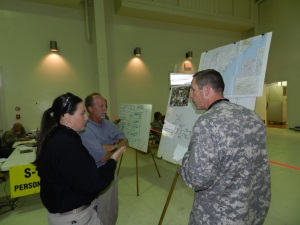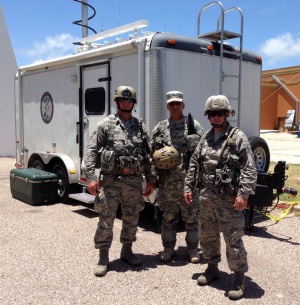BY: CMSgt Paul Lankford, Public Affairs Officer 5th AW
 PORT ARANSAS, TX—On Wednesday morning June 6th the weather in Port Aransas, TX was deceptively calm, with no heavy rains or gusty winds. Preliminary weather reports indicated the approach of a relatively mild storm, which had first formed as a tropical depression two days before in the Gulf of Mexico. The storm was being monitored by Air Force Hurricane Hunters from the 53rd Weather Reconnaissance Squadron, Keesler AFB, MS.
PORT ARANSAS, TX—On Wednesday morning June 6th the weather in Port Aransas, TX was deceptively calm, with no heavy rains or gusty winds. Preliminary weather reports indicated the approach of a relatively mild storm, which had first formed as a tropical depression two days before in the Gulf of Mexico. The storm was being monitored by Air Force Hurricane Hunters from the 53rd Weather Reconnaissance Squadron, Keesler AFB, MS.
By nightfall the weather had quickly changed drastically, and the National Weather Service was now issuing warnings for a full-fledged hurricane with its eye on Port Aransas, Ingleside, Aransas Pass and Corpus Christi. Winds at landfall were now being predicted to exceed 160 miles per hour.
The suddenness of this storm had happened once before on August 3, 1970 with Hurricane Celia, which approached as a mild storm, but left 18 dead, 9,000 injured or sick, over 3,000 homes destroyed or damaged with estimated property losses exceeding $100 million. Celia also accounted for over $50 million in crop loss. This storm, as islanders later put it, “Surely was Celia’s sister.”
COL Vincent Carag, Texas State Guard Commander of the 1st Regiment (REGT) in San Antonio, had been monitoring the progress of the storm, and wisely conducted a practice “recall” on Tuesday night. COL Carag’s gut feeling later proved to be a “game changer.”
The hurricane hit Port Aransas on its march across the island to Corpus Christi, where it hit with devastating consequences. With so little warning, very few people were able to evacuate the area north up I-37 to San Antonio. Port Aransas normally has a year round population of 4,000, but during the summer months it swells to from 40,000 to 70,000. Corpus Christi is a moderate sized Gulf Coast city with a population of about 312,000.
COL Carag initiated a real-world “recall” on Thursday morning assembling a Task Force made up of 150 soldiers and airmen, who would provide evacuee tracking, shelter management, points of distribution, area reconnaissance, wide area assessment, limited search and rescue, area security, and other emergency management missions to protect lives and property in the storm-ravaged area.
Task Force 1st REGT is made up of San Antonio-area TXSG forces, soldiers and airmen who train annually for just such a disaster response. TF 1 REGT commander COL Carag said, “San Antonio is geographically closest to the summer island playgrounds of Padre Island, Port Aransas, Aransas Pass and the city of Corpus Christi, thus we would be the first get the call for hurricane disaster contingency operations.” He emphasized, “That’s what we train for—that’s who we are.”
The scenario described above was the basis for the Annual Training (AT) for TF 1 REGT, which also included the 449th Air Support Group, the Alamo Medical Response Group, and the Engineering Detachment. The 1st BN and 3rd BN of the 1st RGT were the Army components to the Task Force.
“After Hurricane Celia hit the area 43 years ago, much has changed in how we track, prepare and train for hurricane relief,“ explained Rick Adams, Emergency Management Coordinator (EMC) for the city of Port Aransas. EMC Adams, working with Brandi Ashby-Fisher, District Coordinator for Texas Division of Emergency Management (TDEM), COL (USA Ret) Rob Maxham, volunteer Assistant EMC Port Aransas, asked the TXSG executive counsel if they would be willing to conduct disaster training in conjunction with Port Aransas and Nueces County for their Annual Training this year. “We thought this training would benefit both the city of Port Aransas and the TXSG greatly,” COL Carag said.
“Ancillary emergency responders, who aided in the AT hurricane relief scenario were the Red Cross, the Salvation Army, and the Military Auxiliary Radio System (MARS) ‘green egg’,” COL Carag stressed. He explained that the Red Cross aided in shelter management, while the Salvation Army provided meals for the Task Force.
Others involved included the Port Aransas Independent School District (ISD). COL James J. Gardon, Medical Response Group oversaw efforts to house TXSG personnel in the Burnett Middle School gymnasium, and set up the inflatable shelter on ISD grounds.
EMC Rick Adams said virtually every municipal employee was involved in the scenario, “Our Fire and EMS, our Police, our Water Plant personnel, our Waste Water personnel, and our facilities personnel all pitched in to make this a real success.”
Maj Ferdinand Girard, Commander of the 449th ASG, Lackland AFB said it best, “This is as close as you can come to the real thing (a hurricane)—this is exactly the type joint-training we should be doing.”
“Much of the success of this year’s Annual Training scenario belongs to the Operations Officer for 1st REGT, MAJ Don T. Shirley, who coordinated the planning,” said Col Thomas Ball, 5th Air Wing (5th AW) Commander. Members of the 5Th AW were utilized to be “Evaluators” during the exercise. Col Ball provided boat and water safety training in Port Aransas to Army and Air Component personnel. “After hurricane landfall, our troops may be asked to conduct operations around high-water areas, and we want to ensure they can perform those duties safely and effectively,” Col Ball explained.
Overall, COL Carag was pleased with the performance of the task force over the four-day training period. “We ran round-the-clock scenarios, and stressed our people with events much like they would encounter during a real hurricane,” COL Carag said. “Are we better prepared for a hurricane?, you bet we are,” he answered.